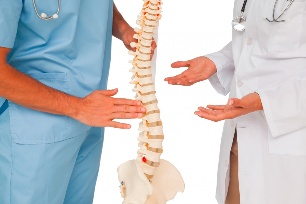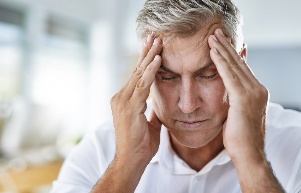
Many people associate the word "osteochondrosis" with aging. There is a view that this is a disease of the grandparents, in which "shoots in the lower back" and "back pain". However, there is only one grain of truth in this illusion: indeed, osteochondrosis isdegenerative(i. e. , caused by a local metabolic disorder)changes in the spine, which are inevitableappear in all the elderly. However, osteochondrosis is now found in 9 out of 10 people over the age of 45 and the first manifestations of the disease can start as early as 25 years old.
This disease is even called"the disease of civilization", as the main cause of osteochondrosis is the improper "exploitation" of the spine. The fact is that a modern person is subjected to excessive loads and, paradoxically, not when running or lifting weights, but when sitting without getting up from a chair for hours. This load is calledstaticand it is very difficult. Because a person thinks he is resting when he is sitting. In fact, the sitting spine works with increased stress.
How the spine works
To understand what osteochondrosis is, you need to understand what the human spine is. We all know that the spine is made up of vertebrae connected by a series of intervertebral discs. In total, a person usually has 33-34 vertebrae: 7 of them form the cervical region, 12 - the thoracic region, 5 (or 6 in a small percentage of people) - the lumbar, 5 more vertebrae, which grow together, form the sacrumand, finally, the coccygeal region consists of five (or four - depending on the individual characteristics) vertebrae. The vertebrae are, in fact, bones and are immobile, but so that they can move freely, providing mobility throughout our body, and also, so as not to collapse from impact and friction, there is a layer of gelatinous substance between each vertebra (the so calledpulposus nucleus) surrounded by strong multilayer plates (annulus fibrosus). Collectively, this is called theintervertebral disc.In addition, the structure of the spine contains many ligaments, vessels, nerves. This is a very complex organ that largely determines the work of almost all body systems, as it protects the spinal cord and affects its work.

The vertebrae and intervertebral discs are constantly renewed throughout a person's life. This is possible due to the fact that good blood is provided and good nutrition is always provided. However, if, for some reason, nutrition begins to flow to the spine in insufficient quantities, the pulposus nucleus loses its properties, the intervertebral disc becomes flat and less elastic, cracks appear in the ring and the vertebrae themselves begin to shift todifferent directions and approaching each other. All this leads to some dangerous deviations - mainly ininflammation both in the spine itself and in the surrounding tissues, as well as in the compression of the spinal cord and spinal nerves.
It is interesting that an idea such as "osteochondrosis of the spine" exists mainly in the post-Soviet space. In the foreign literature, changes that occur in the spine are called"hernias", "myovascular pain", "disc injuries", "dorsopathy". So, if you have heard something similar about yourself, it means that you have osteochondrosis of the spine. As forintervertebral hernia, it is considered one of the stages of osteochondrosis.
The disease is not acute and develops gradually: first, the intervertebral disc narrows, changes degeneratively, thenprotrusions appear- the nucleus appears to be compressed and mixed with fibrin butdoes not break it. When there is a rupture of the fibrous ring, they talk aboutintervertebral hernia.Eventually, the most severe stage of osteochondrosis,the intervertebral discs are completely worn out, the vertebrae begin to rub against each other and also collapse, abnormal bone growths and osteophytes appear on them
Causes of the spine
Why do all of the abovedegenerative changes occur? As already mentioned, the main reason isan abnormal load on the spine:for example, when a person has to sit in awkward positions for a long time, the neck and chestareas are tense and do not receive the necessary nutrition. In addition, osteochondrosiscan develop due to poor posture.However,sports, especially endurance sports, can also lead todegenerative changes in the spinein violation of technical practice
Another common cause isback injury. The development of osteochondrosis can also be affected by hereditary genetic predispositions, hormonal disorders, overweight, unhealthy diet, inadequate water intake and, consequently, dehydration, smoking and alcohol abuse.
Women often experience the first manifestations of osteochondrosis during pregnancy and then, when new mothers have to feed their baby in uncomfortable positions for themselves and often carry him in their arms, the condition of the spinecolumn deteriorates significantly.Symptoms of osteochondrosis
The symptoms of osteochondrosis vary and depend on the exact area where the disorders occurred. Pain is the main manifestation of this pathology, however, until the rupture of the fibrous ringis weak, it can be tiring, stressful and patients may not even pay attention to it.Most often the pain intensifies in the morning or after exercise, radiating to the arms, legs, neck, ribs and chest (in this case, osteochondrosis can easily be confused with coronary heart disease).
In addition, numbness and tingling may occur in the extremities.
With osteochondrosisin the cervical spine, headaches may occur, sometimes very severe, dizziness, nausea, wheezing in the ears. The development of a hernia, which leads to compression of the nerve endings, can lead to disruption of the internal organs associated with the affected nerve. For example, with a hernia in the lumbar spine, there may be problems with urination, loss of strength, chest - indigestion, cervical - problems with blood supply to the brain.

Diagnosis of osteochondrosis
Only a doctor can distinguish osteochondrosis from other diseases of the internal organs and determine the source of pain. Today, the most reliable method for diagnosing diseases of the spine is considered to be magnetic resonance imaging.X-rays are also reliable, but less informative. On an X-ray, you can see changes in the intervertebral discs, but you can not, for example, see a hernia and assess the condition of the spinal cord and the degree of compression by displaced vertebrae. In addition, MRI scans allow you to distinguish osteochondrosis from other dangerous diseases, such as malignancies and Bechterew's disease.
Is it possible to cure osteochondrosis?
Unfortunately, it is impossible to cure osteochondrosis, but it is possible to alleviate the patient's condition andstop further destruction of the intervertebral disc, but for this it is necessary tocompletely change thelifestyle - to do physiotherapy, swimming, attending regular massage classes or manual therapy, start eating right and give up bad habits. Exercise, massage, proper nutrition and weight loss can have significantly greater and longer-term therapeutic effects than medications.
Doctors still disagree about the effectiveness of chondroprotectors - drugs that repair cartilage tissue and are said to strengthen the fibrous ring. to be used to treat osteochondrosis.
For severe pain, your doctor may prescribe non-steroidal anti-inflammatory drugs (NSAIDs), muscle relaxants (drugs that relax muscles) and analgesics.
Used to treat osteochondrosis andvitamins, as their deficiency causes further destruction of the intervertebral disc:B vitamins, for example, contribute to the improvement ofbetween proteins and Protein is the main building block of the body, and then the normalization of protein metabolism helps to restore nerve and cartilage tissue. Vitamin A improves blood circulation. However, taking vitamins, like other medicines, you need to be careful, as they can cause serious side effects and can only be taken with a doctor's advice and under his supervision.
Surgical treatment of osteochondrosis is also possible, but is usually used when there issignificant spinal stenosis and excessive compression of the nerves and spinal cord by the resulting hernias. In this case, the situation is so difficult that the patient, for example, can not walk, his internal organs begin to fail or there is a risk of stroke. Most often, such serious consequences are caused by osteochondrosis of the cervical and lumbar spine, degenerative changes in the thoracic spine, and even the presence of gardens, almost never require surgical treatment.
Today,methods of so-called exchange surgeryare actively introduced into medical practice, when doctors manage to maintain the complete structure of the vertebrae by removing part of the nucleus accumbens using an

















































